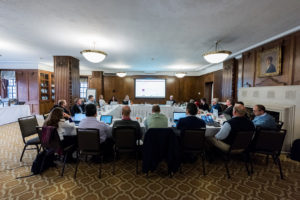
Tom Black from Stanford explained digital certificates used to share the student experience.
As students increasingly take part in unique study opportunities at their colleges and universities, the concept of a traditional transcript to demonstrate learning and competency just doesn’t cut it, university leaders say.
A piece of paper with the name of a course and the letter grade earned also does not begin to capture today’s global and engaged learning experiences, or the depth of knowledge students gain from classes that range from the more traditional to those far from conventional.
“The transcript is often viewed as being inflexible and constrained by bureaucratic rules. Today there exists great opportunities to expand, re-design and create new versions of the academic transcript that provide a richer set of information,” said Paul Robinson, U-M Registrar.
So some universities have been looking at alternative ways of using digital technology to demonstrate outcomes for the students, future employers and graduate schools.
Earlier this month, the University of Michigan brought 15 registrars from top institutions together to for an Academic Innovation event they called The Transcript of the Future. The high-powered group represented public and private institutions collectively enrolling more than half a million students, said Tim McKay, professor of physics, astronomy, and education, and director of the Digital Innovation Greenhouse within the Office of Academic Innovation at Michigan, who kicked off the meeting.
“The transcripts we keep today were designed in the early 20th century, and reflect their origin in industrial bureaucracy. But the world has changed: we live in an information age, and it is time to rethink the way we represent each student’s college experience,” McKay wrote in a recent blog post. “The University of Michigan offers about 9200 courses, varying in size from 1 to 2000, in topics from Abstract Art to Zoology, and in level from introductory to expert. Right now, transcripts record every one of these classes in the same way: subject, course number, abbreviated name, credit hours earned, and letter grade. This is silly. We should recognize that different classes serve different purposes and record what happens in them in appropriate ways.”
Tom Black from Stanford showed the group several versions of digital certifications, used by the schools of medicine, business and education, and two programs that focus on science writing competency and community-based experiences.
The certifications allow students to showcase their competencies in areas like critical and analytical thinking, strategic leadership, innovation and civic engagement, among others.
Black touted the certificates as something a third party, like an employer, can use to validate the student’s experience.
“This gives them the intellectual stuff to have a conversation,” Black said. “People looking at transcripts are not going to go fishing to find out what a community services experience has been for a student.”
Shelby Stanfield from the University of Texas at Austin discussed various technological developments that facilitate the secure sharing of credentialed documents, such as transcripts and diplomas. Stanfield presented ideas on how institutions could use blockchain technology to share learning artifacts ranging from badges and certificates to transcripts. This approach strings together a set of records (the blocks) in a chronological series (the chain) in a particularly secure way: ideal for validated educational records.

Shelby Stanfield from the University of Texas explains blockchain technology and his university’s use of digital badges to demonstrate learning.
Robinson said U-M is a leader in this area through the Office of Academic Innovation and the DIG.
“We have analyzed decades of individual course and grade data and are exploring developing new metrics that provide a better understanding of student learning and student experiences,” he said. “This work on the Transcript of the Future supports the University’s Academic Innovation Initiative in that it seeks to leverage the availability of student, course, and experiential data to develop an academic transcript that better reflects the breadth and depth of learning.”
Registrars also shared a number of best practices and discussed the current state of moving in this direction during the conference. Along with certifications, they talked about digital badges as representations of competency, data technology and emerging options from vendors. The group also spent time discussing ideas for representing additional metrics beyond the traditional GPA on the transcript. McKay shared ideas for developing analytical methods to better measure intellectual breadth and performance. Among the challenges is getting buy-in from leadership, and ensuring that transcripts provide information that is relevant for all audiences: employers, graduate and professional programs, and especially the student’s themselves.
The meeting concluded with higher education leaders agreeing to push forward with the development of “enhanced transcripts” that better serve the needs of students, faculty and other constituents.
In addition to U-M and Stanford, participants were from University of Texas at Austin, Brown University, Cornell, University of Chicago, University of Colorado-Boulder, Indiana University- Bloomington, University of Minnesota, Northwestern University, Penn State University, UCLA, University of Toronto, Vanderbilt University and the University of Wisconsin at Madison.



